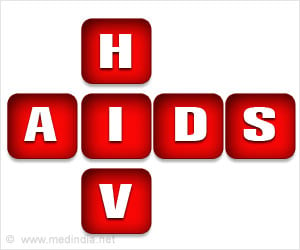Regular use of vaginal ring for a month at a time reduced the risk of HIV infection in women, states a new study.

- Women account for nearly 60% of adults with HIV in sub-Saharan Africa despite advances in preventing HIV
- Vaginal rings are flexible products that fit high up inside the vagina and are easy to use and handle
- The consistent use of a vaginal ring impregnated with the antiretroviral (ARV) drug dapivirine for a month at a time reduced the risk of HIV infection in women
- Dapivirine binds to and disables HIV's reverse transcriptase enzyme, a key protein needed for HIV replication.
ASPIRE-Study
ASPIRE (A Study to Prevent Infection with a Ring for Extended use), or Microbicide Trials Network (MTN-020), was a Phase III trial that involved 2,629 women aged 18-45 years from the African countries of Malawi, Uganda, South Africa and Zimbabwe. The study evaluated the efficacy of a medicated vaginal ring in the prevention of HIV. Vaginal rings are flexible rings that are fitted high up in the vagina by the women themselves. Medicated rings release a medication over a prolonged duration. The ring tested in the ASPIRE study contained 25 mg of the anti-HIV drug dapivirine, about 4 mg of which gets released over 28 days. Dapivirine, also known as TMC-120, belongs to a class of drugs called non-nucleoside reverse transcriptase inhibitors (NNRTIs). Drugs from this group disable HIV's reverse transcriptase enzyme, a key protein needed for HIV replication. The ASPIRE study concluded that the ring reduces the risk of HIV infection by 27%.This finding is being reported at the 21st International Conference On AIDS in Durban, South Africa. The ASPIRE results were published online in the New England Journal of Medicine.
"Adherence to HIV prevention strategies is not always perfect, and we knew that not all women used the ring consistently, so we developed an analysis to explore the degree of HIV protection that was associated with more consistent use," stated Dr. Brown "Across all analyses we saw high adherence was associated with significantly better HIV protection." Dr. Brown added.
"The findings from the ASPIRE study told us how much protection the dapivirine ring afforded the study population as a whole, which included women who used the ring often, sometimes, or not at all," explained NIAID Director Anthony S. Fauci. "However, we know that HIV prevention tools work only if people use them. The findings of the exploratory analysis reported today give credence to the hypothesis that greater adherence to the dapivirine ring translates into a higher level of protection. The HOPE trial will provide additional data that either reinforce or refute this hypothesis,” he added.
HOPE-Study
Another clinical trial called HOPE (HIV Open-Label Extension) or MTN-025, will be build on ASPIRE study. Women eligible for this study will be those who have participated in the ASPIRE study earlier and have not contracted the HIV virus. All the women who enroll will be offered the ring. In the initial three months, the women will receive the ring on a monthly basis. Following this period, they will be offered three rings at a time on every quarterly visit, which is more likely to be the case in a real-world setting. The study period will last for one year.The choice to use the vaginal ring or not, however, will be the woman’s. This would reflect the women’s acceptance of the ring. Adherence to the ring will be determined by measuring residual levels of dapivirine in returned rings and blood levels of dapivirine. Women will be able to stay in HOPE for about a year after they enroll regardless of whether they accept or use new rings. The HOPE study will gather additional information on the ring's safety and how women use the ring.
"The HOPE study will give us the opportunity to learn why women do or do not like to use the dapivirine ring- information that might help us plan the optimal approaches for its delivery outside of research settings, improve upon the product and clarify how different HIV prevention options fit into women's lives," said Dr. Jared Baeten.
Study Team
The ASPIRE study was led by Dr. Jared Baeten, from the University of Washington in Seattle, and Dr.Thesla Palanee-Phillips, from the Wits Reproductive Health and HIV Institute in Johannesburg, South Africa. They will also lead the HOPE study together with Dr. Nyaradzo M. Mgodi, from the University of Zimbabwe-University of California San Francisco in Harare.References:
- Vaginal ring may cut HIV infection risk if used consistently - (http://www.eurekalert.org/pub_releases/2016-07/nioa-vr071716.php)
- HIV and AIDS in sub-Saharan Africa - (https://www.avert.org/professionals/hiv-around-world/sub-saharan-africa)















